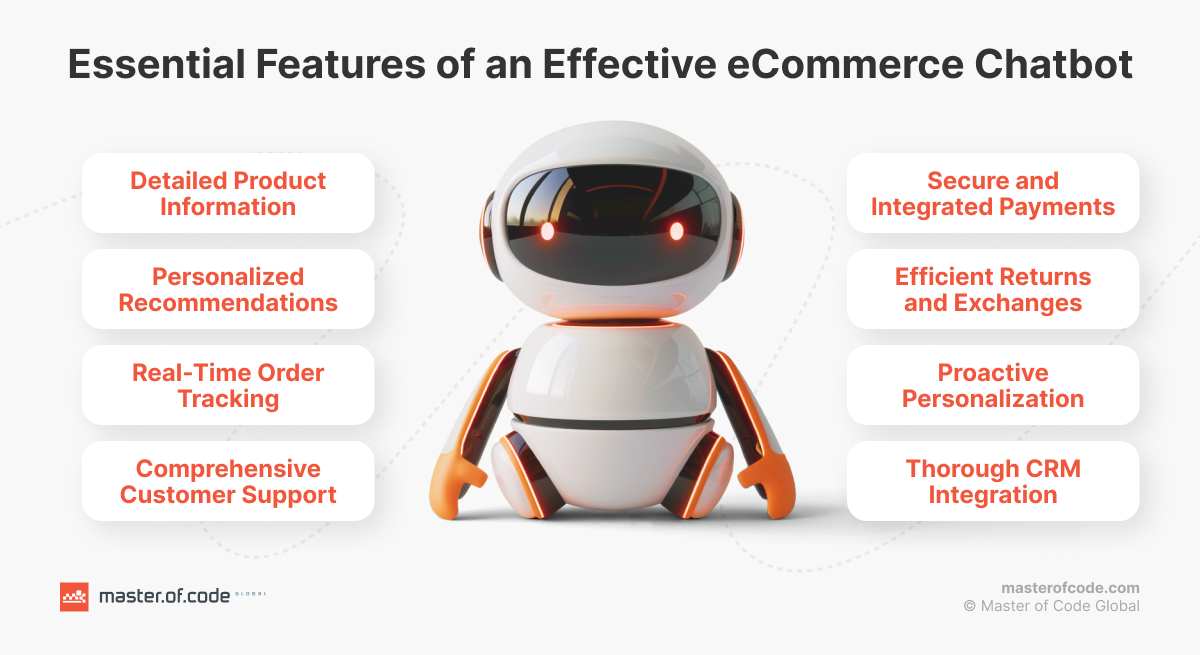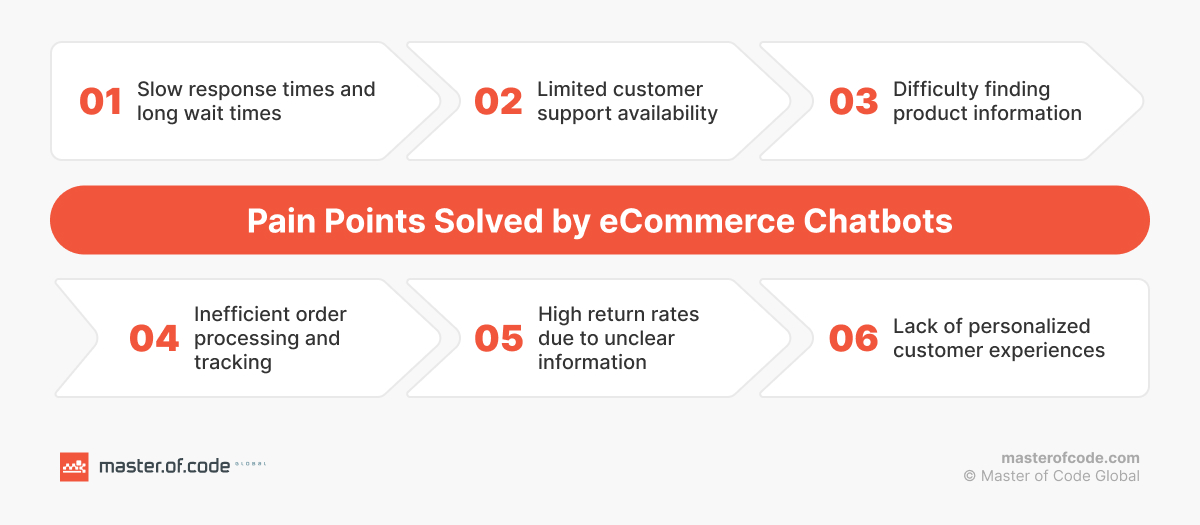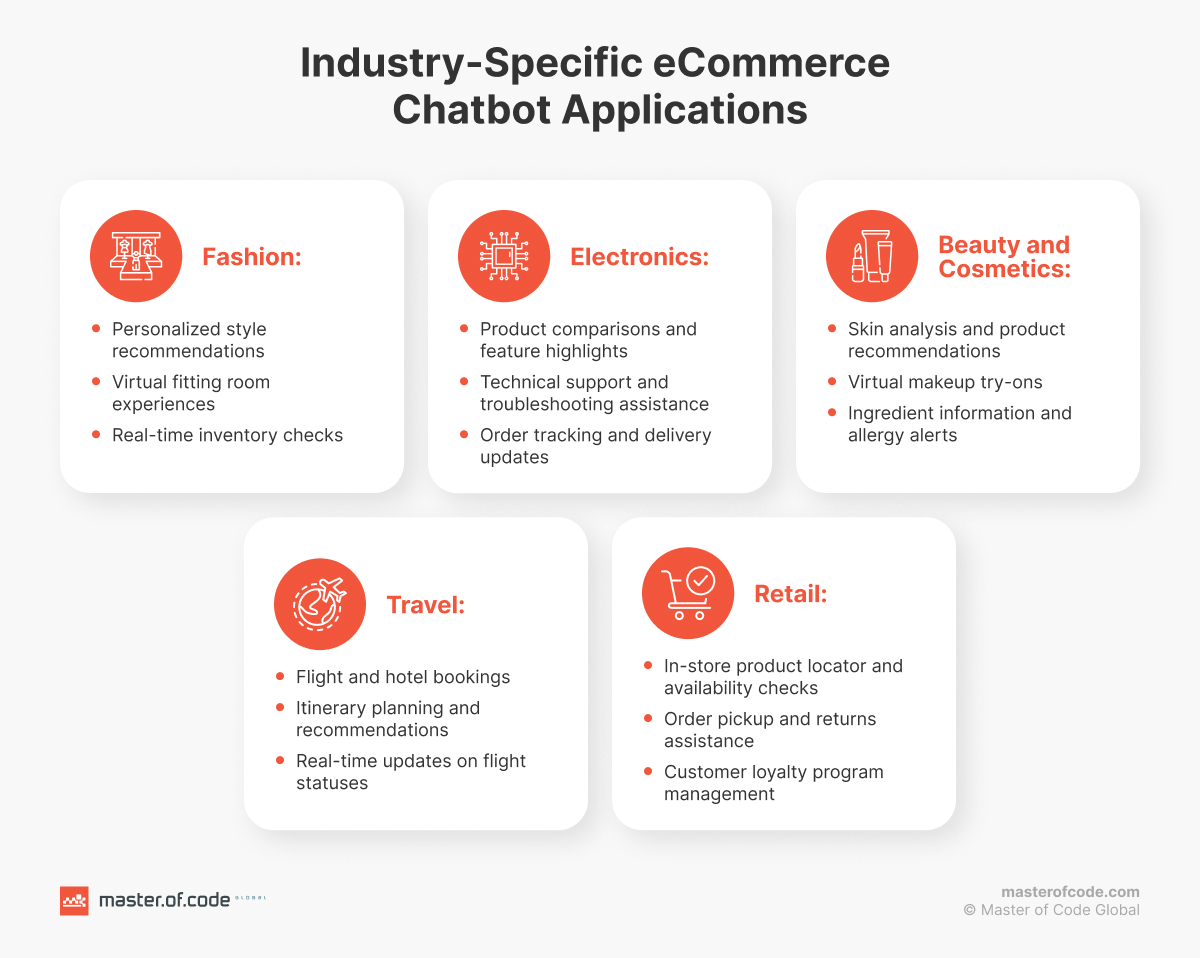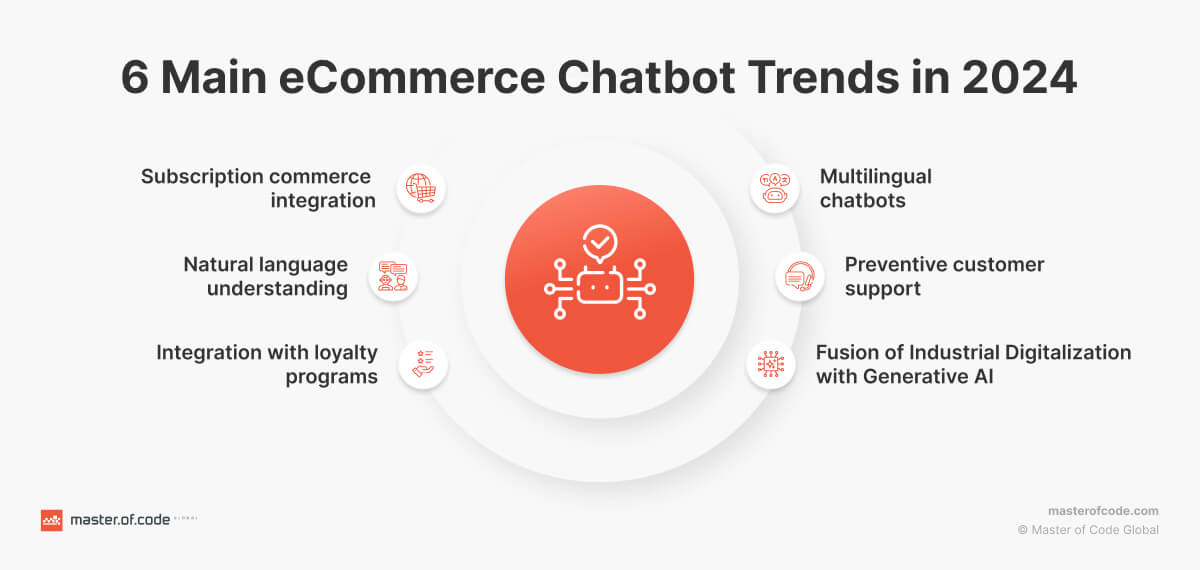In today’s tough online retail landscape, every sale counts. Customers crave instant gratification and personalized experiences. Enter eCommerce chatbots: the digital saviors ready to turn casual browsers into loyal clients. From handling FAQs with lightning speed to upselling with finesse, these AI-powered assistants are the secret weapon your business needs.
Imagine a world where your users have 24/7 access to a knowledgeable and always-friendly sales rep. With the right eCommerce AI chatbot, this dream becomes a reality. These virtual assistants can handle everything from recommending the perfect product to resolving issues swiftly. Not only do they enhance satisfaction, but they also free up your support and sales teams to focus on more complex tasks. In this article we will explore eight champions that could be the game-changer for your online store.
Table of Contents
The Most Significant eCommerce Chatbot Statistics To Consider
Buckle up for a data-driven thrill ride! Bots aren’t just a trend; they’re reshaping the landscape. From boosting sales to delivering exceptional customer journey, the numbers speak volumes. Get ready to be amazed by the hard facts that prove bots are the secret sauce for online success. These stats will convince you that eCommerce chatbots aren’t just an option – they’re a necessity.
Strategies for building chatbots tailored to elevate eCommerce performance.

Did you know that a giant percentage of consumers prefer interacting with virtual assistants over human agents? Or that businesses using bots have seen a significant increase in sales? These numbers are just the tip of the iceberg. By understanding the impact of eCommerce chatbots on generating profit and boosting operational efficiency, you can make data-driven decisions to optimize your strategy. Let’s dive into the numbers and uncover the true potential of these solutions.
- The use of chatbots in eCommerce by brands has increased by 92% in recent years.
- Around 1.4 billion people are using virtual assistants nowadays.
- More than 40% of shoppers utilize conversational commerce tools to assist with their buying and selling activities.
- A well-designed chatbot system can efficiently manage 80% of straightforward user inquiries without any problems.
- 27% of individuals couldn’t tell if their most recent customer service interaction was with a human or an AI chatbot for eCommerce websites.
- The majority of shopping journeys begin online, with 41% starting at online stores (EcommerceDB).
- Online chat or bots are a more popular communication channel for female online shoppers, with 49% preferring it over 37% of male consumers.
- Over 60% of people find it more irritating when AI fails to resolve an issue compared to a human agent.
- The number of online shoppers reached 2.71 billion by the year 2024.
- Global online sales are expected to exceed $6.3 trillion in 2024.

The Impact of eCommerce Chatbots on Business Expansion
Incorporating Сonversational AI for eCommerce into your strategy offers multifaceted benefits. These intelligent assistants streamline client support, providing instant responses and personalized recommendations around the clock. They can boost sales by offering smart product suggestions and promoting special offers. Additionally, such bots excel in lead generation by capturing user data and seamlessly integrating with multiple platforms.
- Increase Conversion Rates. An eCommerce chatbot has the capability to initiate real-time interactions with customers, assisting in resolving their questions and maneuvering them through the purchase journey. As noted by AI Multiple, these tools have the potential to elevate conversion rates by as much as 67%. Such an effectiveness stems from the bots’ ability to assist users during online shopping by providing relevant information and guiding them through the checkout process.
- Boost Lead Generation. By initiating conversations and collecting user information, a chatbot can identify potential leads and capture essential data. This information can then be used to tailor marketing efforts and nurture these prospects into becoming valuable consumers.
- Enhance Sales. Chatbots for eCommerce offer individualized product recommendations based on user preferences and behavior. This capability can significantly contribute to cross-selling and upselling, leading to larger order values and increased revenue for your business. As indicated by Juniper Research, bots are projected to contribute to a retail sales value of $112 billion.
- Instant Client Support. Approximately 60% of customers express that prolonged holds and waiting times constitute the most frustrating aspects of a user service. One of the key advantages of an online retail bot is its round-the-clock availability to address inquiries. This ensures that people receive timely assistance, resulting in elevated satisfaction levels and loyalty.
- Integration with Multiple Platforms. An eCommerce chatbot can be seamlessly incorporated across your website, social media, or messaging apps. This consistency in client experience ensures that no matter where people engage with your brand, they receive the same quality of assistance from the AI.
- Improvement in Advertising Efforts. The best agents can engage users with targeted promotions. They can provide relevant information and even enable direct purchases within the chat interface. This heightened functionality impacts the effectiveness of your advertising campaigns and drives more conversions.
- Reduce Support Costs. By automating FAQs, order tracking, and returns, bots free up human agents for complex issues. This reduces ticket volume, improves response times, and ultimately lowers overall costs. So, we can consider an eСommerce chatbot as an economical solution to handle routine customer inquiries.
7 eCommerce Chatbot Use Cases That Drive Your Business Success
1. Answer FAQs Immediately
- Speed: Virtual assistants provide quick responses to requests, improving contentment and reducing wait times. Bots can decrease routine question response times by as much as 80%.
- NLP: Equipped with natural language processing, chatbots understand and provide answers to customer inquiries in a natural, conversational manner.
2. Upgrade Client Engagement
- Customer Info Collection: Conversational agents can gather valuable data, such as preferences, purchase history, and contact information. These insights can be used to create personalized approaches and targeted marketing campaigns.
- Cart Abandonment: The stats show that products in abandoned carts add up to $4 trillion per year. By proactively engaging with people who don’t complete their purchases, eCommerce chatbots can recover lost sales. They can offer incentives, answer questions, or simply remind users about their forgotten items.
- Product Search: Advanced NLP-powered bots can also understand complex product queries, helping users find exactly what they’re looking for. For instance, Louis Vuitton’s chatbot can assist shoppers in finding the perfect bag based on their preferences, occasion, and budget.
3. Automate Sales
- Personalization: Motivated by the potential for a reliable return on investment, 79% of retailers are investing in tailored approaches. Product recommendation chatbot can deliver special offers based on consumer behavior and preferences with the help of personalized shopping encounters, increasing the likelihood of purchases.
- Marketing: By conducting interactive quizzes or surveys, conversational tools collect data and segment audiences for targeted campaigns. Chatbots for eCommerce sales help businesses promote relevant products and services and transform Customer Experience (CX).
4. Provide Exceptional Virtual Shopping Assistant
eCommerce chatbot can guide people through the whole purchasing process. For example, Kiehl’s chatbot recommends skincare products based on skin type and concerns. Additionally, it offers expert advice and tips on how to maintain a healthy daily routine, ensuring you get the most out of your beauty products.
Levi’s shopping chatbot also helps customers find the perfect pair of jeans by asking about their preferred fit, style, and size. A study conducted by Idealo revealed that buyers who interacted with a live chat representative experienced the highest level of service satisfaction, reaching 73%.
5. Deliver Superior Post-Sale Support
- Upselling & Cross-Selling: Allocating just 5% of resources to customer retention has been demonstrated to increase profits by at least 25%. AI bots can suggest complementary products or upgrades after a transaction, increasing average order value.
- Issue Resolution: By addressing common post-purchase concerns, virtual agents can reduce frustration and assistance ticket volume.
- Order Tracking: Conversational AI can provide real-time updates, keeping consumers informed about the status of their shipments.
- Decrease Refunds: By offering clear product information and assisting with sizing or compatibility, eCommerce chatbots reduce returns significantly. This way, companies can witness noticeable savings.
6. Utilize Customer-Centric Data
- Feedbacks & Reviews: Brands that prioritize client-oriented approaches report profits that are 60% higher than those that do not emphasize customer experience. An AI eCommerce assistant easily collects user feedback and reviews, providing valuable insights into product performance and enjoyment.
- Trends & Data Analysis: By examining eCommerce chatbot interactions, businesses can identify emerging trends, user preferences, and areas for improvement. These insights inform product development, marketing strategies, and client service initiatives.
- Product and Service Refinement: Companies can improve their product offerings and assistance to better meet customer needs with the help of analyzing feedback and identifying pain points.
7. Gain Real-Time Interaction Insights
- Conversation Documentation: According to 64% of customers, the best aspect of using a chatbot is having access to 24/7 service. Bots can record and analyze conversations to identify common questions, pain points, and opportunities for improvement. They instantly gather all the data and represent it in a form of clear and comprehensive reports.
- Pattern Identification: By analyzing interaction models, businesses can figure out areas where the AI is struggling and make necessary adjustments.
- Data-Driven Decisions: The data collected through eCommerce chatbot interactions can be used to make effective Conversational AI marketing campaigns and informed decisions, such as optimizing product offerings, improving support, and increasing sales.

Elevating Customer Engagement with an eCommerce Chatbot
Today consumers expect immediate, personalized interactions. Diverse Conversational AI solutions offer a powerful tool to meet this demand and elevate engagement. Whether you’re already utilizing a bot or are contemplating the potential of the technology, Master of Code stands ready to provide guidance and assistance in Conversational AI services. To maximize the impact of your virtual helper, consider these essential strategies.
Define eCommerce Chatbot Use Cases Before Launch
What specific goals do you aim to achieve? Are you looking to increase sales or gather valuable insights? Before implementing chatbots for efficient customer service in eCommerce, clarify its purpose. Identifying clear use cases will guide the bot’s development and ensure it aligns with your business objectives.
For instance, if your primary goal is to boost sales, the solution could focus on product recommendations, cart abandonment recovery, and upselling opportunities. On the other hand, if improving facilities is the priority, your AI chatbot for eCommerce should excel at answering FAQs, resolving issues, and providing order tracking information.
Prioritize Top Customer Touchpoints
Consider where your audience spends most of its time online. Is it your website, social media platforms, or messaging apps? Prioritize these channels for bot implementation. Focusing on the most-used touchpoints ensures maximum reach and engagement.
For example, if your target audience is primarily on Facebook Messenger, investing in this virtual assistant could yield significant results. However, don’t neglect other channels, especially if your customer base is diverse.
Keep Conversations Easy
A complex chatbot for eCommerce can frustrate people. Keep dialogs and other interactions straightforward and easy to follow. Use clear and concise language, and avoid overwhelming shoppers with too many options. The bot should guide them through the conversation seamlessly.
For instance, an AI tool asking “How can I help you today?” with options like “Order status,” “Product information,” or “Returns” is more effective than a long list of unrelated points to choose from.
Master Common Queries with FAQs
A well-structured knowledge library is essential for eCommerce chatbots. Anticipate common questions and provide clear, informative answers. This not only saves time for both consumers and agents but also demonstrates your brand’s commitment to excellent client service. A fashion retailer might include FAQs about shipping times, return policies, sizing, and product care.
Integrate Chatbots Throughout the Funnel
Virtual agents can be valuable assets during the whole customer journey. From attracting new visitors to nurturing leads and providing post-purchase help, bots can enhance every interaction.
An eCommerce chatbot can proactively greet new visitors, offer product recommendations, assist with purchases, and provide order tracking information. By being present at every stage, such assistants build trust and loyalty.
Seamless Handover to Humans
While a chatbot is capable of handling many client inquiries, there will be times when a human agent is indispensable. It’s essential to have a quick and smooth automatic escalation process to avoid frustrating the audience.
As an example, if a virtual assistant cannot resolve a client’s issue, it should politely offer to transfer the conversation to a qualified agent. This demonstrates that the company values user contentment and is committed to providing individualized support.
Capture Customer Data for Personalization
Integrating the AI-powered chatbot with your CRM system is crucial for a tailored approach. By collecting and storing client data, you can easily personalize various user interactions and offer relevant recommendations.
An AI agent can greet returning consumers by name and suggest products based on their purchase history. This level of personalization enhances enjoyment and builds loyalty, minimizing customer churn rates.
Refine Chatbot Based on User Feedback
Interactive agents are not static; they require constant improvement. Monitor your AI chatbot for eCommerce performance, analyze interactions, and identify areas for enhancement. Regularly update the knowledge base and refine its language to ensure optimal performance.
If a bot frequently encounters a specific issue, it might be necessary to add new responses or improve existing ones. By continuously monitoring and optimizing, you can ensure that your AI is always delivering the best possible outputs.
Beyond these core principles, there are additional strategies to consider for elevating customer engagement:
- Personality and Tone of Voice: Give your bot a distinct character that aligns with your brand. A friendly and helpful tone can create a more positive impression.
- Visuals and Interactive Elements: Incorporate images, GIFs, and engaging features to make conversations with eCommerce chatbots more exciting.
- Proactive Engagement: Anticipate client needs and initiate communication actively. For instance, an AI assistant could offer assistance during peak shopping hours or send personalized recommendations.
- Multi-Channel Integration: Ensure seamless experiences across different platforms to provide consistent endorsement.
- A/B Testing: Experiment with different flows, messaging, and visuals to optimize performance.
- Data Privacy and Security: Prioritize protection and comply with relevant regulations to build trust with your customers.
By combining these strategies with a deep understanding of your target audience, you can integrate an AI chatbot for eCommerce that not only meets but exceeds expectations. A well-implemented tool can significantly increase sales and strengthen brand loyalty.

The Most Popular Online Retail Channels
Apple Messages
Apple Messages for Business (AMB) offers a premium, privacy-centric way to connect with customers directly within their native iOS environment. With AMB integration, brands can seamlessly blend AI innovation and personalized communication—transforming every interaction into an opportunity to impress, resolve, and retain. Customers can initiate conversations right from Maps, Safari, or product pages, and receive real-time support from a chatbot or live agent. Whether it’s answering product questions, scheduling deliveries, or completing transactions, Apple Messages offers a smooth, branded experience. It’s the future of customer service—where each message becomes a step toward deeper trust and consumer loyalty. Ideal for companies seeking to elevate client engagement while maintaining Apple’s gold standard of UX.
Website
The cornerstone of any business, a site remains the primary platform for online sales. It offers complete control over branding and product presentation. With advancements in web design and technology, enterprises can create engaging and user-friendly online store chatbot. Features like personalized product recommendations, seamless checkout processes, and high-quality product images are essential for driving conversions. However, relying solely on a website might limit your reach, especially among younger generations.
Once primarily used for personal messaging, WhatsApp chatbot for eCommerce has transformed into a powerful platform. Its user-friendly interface and high engagement rates make it an attractive channel for companies. By leveraging WhatsApp Business, organizations can connect with people directly, offering personalized support, order updates, and promotional offers. The platform’s ability to share images, videos, and documents makes it perfect for showcasing products. Still, WhatsApp has limitations in terms of product catalog management and analytics compared to dedicated platforms.
With billions of active users, Meta is a social media giant that can’t be ignored. While primarily a social platform, it offers robust features through Facebook Shops. Companies can create online stores, showcase products, and process orders directly within the app. The advertising capabilities allow for targeted campaigns to reach specific demographics. Yet, the eCommerce chatbots algorithm can be challenging to navigate, and organic reach can be limited.
Google Business Messenger
As part of the huge ecosystem, RCS offers a seamless integration with Google Search. Customers can easily find and interact with shops directly from search results. This type of an eCommerce chatbot is particularly effective for local firms looking to connect with users in their area. While still relatively new compared to other platforms, RCS has the potential to become a major player in the retail space, especially as Google continues to invest in its Conversational AI services for eCommerce.
Choosing the Right Option
Selecting the optimal enterprise AI chatbot for eCommerce depends on your target audience, products, and business goals. Many companies find success by using a multi-channel approach. For example, a fashion brand might use its website for core product offerings, WhatsApp for people support and personalized styling advice, Facebook for building brand awareness and engaging with a wider audience, and Google Business Messenger for local promotions.
It’s essential to analyze your customers’ behavior and preferences to determine which channels are most effective. Tracking key metrics like conversion rates, engagement, and return on investment can help you optimize the whole channel strategy. Additionally, staying informed on the latest trends and platform updates is crucial for staying ahead of the competition.

Best eCommerce Chatbot Examples on the Market
Digital assistants have become indispensable tools for firms across industries, and a virtual marketplace is no exception. These AI-powered solutions offer a plethora of benefits, from improving your journey to boosting sales. Let’s explore some of the most impressive eCommerce chatbot examples.
La Mer
Luxury skincare brand La Mer partnered with Master of Code Global to build a sophisticated chatbot experience that acts as a digital skincare concierge. Designed to guide and educate, the bot delivers personalized product recommendations and supports customers throughout their journey. With over 3,350 expertly trained utterances, the assistant understands a wide range of skincare queries and concerns. It also launched with five new interactive features—from regimen building to skin-type diagnostics—boosting user engagement and deepening brand connection. The result is a seamless blend of luxury, technology, and personalization.
Burberry
To elevate digital engagement and inspire modern shoppers, Burberry teamed up with Master of Code Global to launch a storytelling-driven eCommerce chatbot on Facebook Messenger. This Conversational AI concierge allowed users to shop runway looks, receive curated product suggestions, and explore exclusive behind-the-scenes content—all within a personalized chat experience.
More than just transactional, the bot invited fashion lovers into Burberry’s world. Users could live stream fashion shows, learn about the design inspiration behind each collection, and uncover limited-edition pieces based on their preferences. By blending commerce with narrative, Burberry redefined how consumers emotionally connect with luxury online.
Luxury Fashion Consignment Leader
Master of Code Global crafted a high-end virtual assistant for a top luxury consignment marketplace—one that supports both buyers and sellers through every step of the transaction journey.
Tailored for the unique demands of secondhand luxury retail, the chatbot helps buyers navigate product details, negotiate purchases, and resolve post-order concerns. For consignors, it streamlines communication and offers timely guidance throughout the selling process.
By combining robust automation with a premium user experience, this assistant fosters trust and drives repeat engagement. With a 91% first-contact resolution (FCR) and 89% average CSAT, it proves that even complex, high-value purchases can be supported through conversational AI—securely and efficiently.
Tom Ford Beauty
To elevate customer engagement during the busy holiday season, Tom Ford Beauty partnered with Master of Code Global to launch a personalized Facebook Messenger chatbot as part of their Gift Finder campaign. The AI-powered assistant offered a conversational, human-like experience that helped users discover the perfect products based on their preferences, interests, and gifting needs.
By leveraging data from Tom Ford’s website, backend systems, and past user interactions, the bot delivered tailored recommendations that felt both relevant and luxurious. The experience transformed the typical online browsing journey into something more intuitive and emotionally engaging.
The results spoke for themselves: over 8,000 users engaged with the chatbot during the campaign, generating 2,000+ product clicks and redirects to the Tom Ford eCommerce site—demonstrating the power of conversational AI to drive seasonal sales and strengthen brand connection.
Zipify Agent Assist Case Study
To help Zipify scale support without compromising quality, Master of Code Global designed a tailored AI solution focused on internal efficiency and agent empowerment. The project included two strategic components: an intelligent virtual assistant and a real-time analytical dashboard.
The AI assistant was embedded directly into support workflows, enabling agents to quickly access relevant customer information, suggested replies, and contextual resources—reducing handling time and improving consistency across interactions. Meanwhile, the custom-built dashboard provided leadership with actionable insights into team performance, ticket trends, and resolution bottlenecks.
This dual approach empowered Zipify’s support team to handle increasing volumes with ease, transforming reactive service into a proactive, data-informed operation. With automation handling repetitive queries and surfacing key insights, Zipify elevated its service quality while staying agile at scale.
BloomsyBox
This flower subscription service has successfully leveraged bots to streamline user interactions. Their AI agent, developed by Master of Code Global in tight partnership with Infobip, assists people in selecting the perfect bouquet, adjusting delivery dates, and providing order updates. By automating routine inquiries, BloomsyBox has freed up human agents to focus on more complex issues.
SnapTravel
In the travel and hospitality industry, where information overload is common, SnapTravel’s eCommerce chatbot shines. It helps users find the best hotel deals by asking a few simple questions about preferences and budget. The tool also provides real-time updates on flight prices and offers personalized recommendations.

Nike StyleBot
Nike’s StyleBot is a prime example of how an AI chatbot for eCommerce can make shopping even more enjoyable. This smart stylist helps people find the perfect outfit by asking about their style preferences, occasion, and desired look. StyleBot then suggests products based on the provided information, creating a tailored and engaging shopping journey.
Aerie
The lingerie brand has successfully integrated eCommerce chatbots into its assistance strategy. Their AI bot provides quick answers to frequently asked questions, assists with order tracking, and offers styling advice. By introducing 24/7 support, Aerie has improved customer satisfaction and built a loyal user base.
Whole Foods
Whole Foods, conversational commerce bot on Facebook Messenger has embraced chatbots to help customers navigate their vast product assortment. The AI chatbot for eCommerce provides nutritional information, suggests recipes based on dietary restrictions, and assists with online ordering. By offering an individual-focused and informative shopping process, Whole Foods has strengthened its position as a leader in the health and wellness market.
Lidl’s Winebot
The discount supermarket chain took a unique approach with its Winebot. Designed to help users select the perfect drink, the bot asks about taste preferences and food pairings. Winebot then offers recommendations based on these very personal details, likes and dislikes, making wine shopping fun and engaging.
Sephora Facebook Messenger Chatbots
Sephora has been at the forefront of chatbot innovation, utilizing Facebook Messenger to interact with customers. Since its launch, their AI bot has resulted in an 11 percent increase in conversions. This virtual agent offers personalized product recommendations, allows people to book beauty appointments, and provides information about store locations. Also Sephora’s conversational chatbot for eCommerce has been praised for its engaging tone.
Dom Juan (Domino’s Pizza)
This pioneer in online ordering has developed the Dom Juan chatbot. Their assistant allows consumers to select pizza, track order status, and find nearby restaurants. Dom Juan’s ability to handle complex orders and provide real-time updates has contributed to Domino’s success in the online pizza market.
Subway (Google RCS)
Google Rich Communication Services is a new messaging protocol with endless use cases for business messaging. It also supports advanced bots. Subway has partnered with Google to offer an optimal experience through the RCS channel. This messaging platform allows for rich interactions, including images, videos, and interactive elements. Subway’s tool helps people customize their sandwiches, find nearby stores, and access exclusive offers.
These are just a few examples of how companies are leveraging bots to drive sales and please their target audience. As AI chatbot for eCommerce technology continues to evolve, we can expect even more innovative and engaging applications in the web-based shopping space.
RCS Business Messaging: See It in Action
Upgrade from basic SMS to immersive, branded conversations with RCS Business Messaging (RBM). Share product images, videos, carousels, and quick replies—right inside the native messaging app.
RCS drives results: brands report up to 40% higher click-through rates, and 74% of shoppers prefer engaging with brands via RCS. With $15B in new messaging revenue expected by 2028, now’s the time to act.
Want to see it live?
Watch the demo and discover how Master of Code Global transforms customer engagement with RCS.
Conclusion
Chatbot development services are transforming customer interactions and business operations. Bots provide instant help, personalized recommendations, and streamline processes, catering to modern consumer demands. Their effectiveness in online retail is evident by the preference for conversational solutions over traditional service settings. As technology advances, AI bots’ capabilities will further reshape online commerce. The future holds a promising collaboration between human ingenuity and virtual assistants, continuously elevating engagement in the eCommerce sector.
Ready to build your own Conversational AI solution? Let’s chat!






